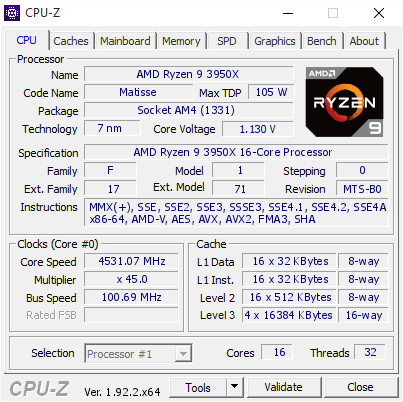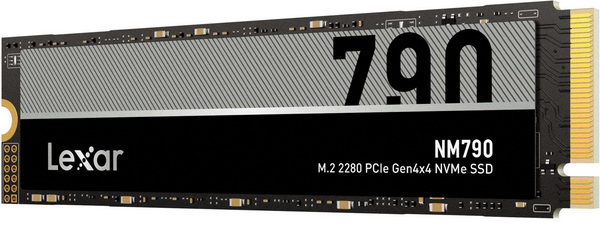INTRODUCTION

PCIe 5.0 Gen5 solid state drives may be currently leading the industry in terms of read & write performance but due to the fact that just a very small segment of the market already owns compatible motherboards (not to mention that temperature issues are also not entire resolved) storage media manufacturers are instead focused more in the development and production of affordable PCIe 4.0 Gen4 models (can't blame them for wanting to sell large quantities). Lexar is one such manufacturer and so today I’ll be testing their latest PCIe 4.0 Gen4 SSD, the NM790 2TB.
For more than 25 years, Lexar has been a trusted leading global brand of memory solutions. Our award-winning lineup includes memory cards, USB flash drives, card readers, solid-state drives and DRAM. With so many options, it’s easy to find the right Lexar solution to fit your needs. All Lexar product designs undergo extensive testing in the Lexar Quality Labs with more than 1,100 digital devices, to ensure performance, quality, compatibility, and reliability. Lexar products are available worldwide at major retail and e-tail stores. For more information or support, visit www.lexar.com.
The latest NM790 line of PCIe 4.0 Gen4 M.2 NVMe SSDs is currently available in 512GB/1/2/4TB capacities and is yet another model to feature MaXio's DRAM-less MAP1602 12nm quad-channel (R5) NAND flash controller which Lexar has this time paired with 232-layer 3D TLC NAND flash by YMTC (X3 variant - Longsys branded). Once again, the MAP1602 12nm quad-channel NAND controller by MaXio packs quite a few features including advanced wear leveling algorithms, Host Memory Buffer (HMB) architecture (uses a fraction of your PC's system memory to cache mapping tables), pseudo SLC cache, bad block management strategy, hardware error-correction, L1.2 ultra-low power state and sudden power-loss protection, TRIM, NCQ, hardware support for AES256/SM4 encryption and support for TCG OPAL2.0. Last but not least Lexar covers the entire NM790 line with a 5-year limited warranty and reports a MTBF of 1.5 million hours for all variants and a TBW (terabytes written) of 500 for the 512GB model, 1000TB for the 1TB model, 1500 for the 2TB model and 3000 for the 4TB model.
SPECIFICATIONS AND FEATURES

PACKAGING AND CONTENTS
Typically, the front of the box has a product picture, advertised performance, capacity and the company logo.
The main product features are listed at the rear along with warranty information and contact details for Lexar.
A quick installation guide and a mounting screw are the two things placed in the box alongside the NM790 SSD.
THE NM790 2TB
The NM790 2TB has a sticker on top which includes the company and model names.


 Removing the sticker reveals the MaXio MAP1602 NAND flash controller and two 232-layer 3D TLC NAND flash modules (2 spots are empty obviously for the 4TB variant).
Removing the sticker reveals the MaXio MAP1602 NAND flash controller and two 232-layer 3D TLC NAND flash modules (2 spots are empty obviously for the 4TB variant).
Turning the SSD around we find yet another sticker which includes the serial and part numbers, barcode, country of manufacture and several certifications and warnings.
TEST BED


TESTING METHODOLOGY
Not long after I first started testing SSDs back in 2008, I concluded that it's almost impossible for any single benchmark suite to accurately measure their performance and that's why in certain benchmark suites we see amazing read/write performance numbers with some drives while in others things are quite different. The reason behind this is that some benchmarking suites are configured to read and write random chunks of data while others read and write constant (sequential) ones. So that's why i always use a very wide selection of benchmarking suites including AIDA64, HD Tach RW, HD Tune Pro, Crystal Disk Mark, Sisoftware Sandra Pro, AS SSD, IOmeter and ATTO. To get the most accurate results each test gets repeated a total of 6 times with the average performance numbers recorded into the charts*/****. Also, as of February 25th 2015 our results will also include the Storage Networking Industry Association’s (SNIA) IOMeter tests. These tests include a 12 Hour write test used to “simulate” performance degradation over time and a mixed workload test which basically shows what you can expect when using an SSD continuously for roughly two hours. Unfortunately, due to the time required for these tests they get repeated a total of 3 times and not 6 as the above.
Many people have made inquiries about our charts in the past so once again please do keep in mind that the Charts have the average performance numbers of each drive recorded and not the peak (highest) ones. Also, although every single one of these programs can help potential buyers choose the right drive for their needs you should also remember that from any kind of benchmark up to real world usage the gap is not small (and usually most differences will go unnoticed by most people). All tests were performed in a fresh Windows 10 Pro x64 installation complete with every update up to the date of this review.
* Since November 2018 the SSD comparison charts have been divided to 2.5” and M.2 models to reduce their growing size.
** Unless stated otherwise the Ryzen 9 3950x based Test Rig used for M.2 Gen 4 SSD reviews is not located in the lab.
*** As of January 2021 for Gen 3x4 models I’ll be using the Core i9-7980XE test rig (after numerous tests the up to 6% difference in read & write performance compared to the i7-6700 system simply wasn’t enough to justify having an extra test rig around).
**** Since February 2022 M.2 NVMe Gen3 and Gen4 SSD drives are placed in different charts.
TEST RESULTS - AIDA64 / ATTO


TEST RESULTS - HD TACH RW / HD TUNE PRO


TEST RESULTS - SISOFTWARE SANDRA PRO / CRYSTAL DISK MARK


TEST RESULTS - AS SSD / IOMETER


TEST RESULTS - IOMETER SNIA

CONCLUSION

Even though the MaXio MAP1602 NAND flash controller is not among the leading ones in the market (the lack of DRAM is quite evident across the board after all) it does well overall and should be plenty for most consumers. Now, I was a bit surprised to see that the GM7 model by ACER which uses the same did quite better but that could be both due to the NAND used and of course the firmware (MaXio probably tailors the firmware according to the needs of each manufacturer). That being said however the Lexar NM790 does deliver in terms of overall performance so all that’s left is cost.
With a current price tag set USD109.99 inside the USA (Amazon.com) and at 111.20Euros inside the EU (Amazon.de) the NM790 2TB Gen4 SSD by Lexar is priced well. At the end of the day the NM790 Gen4 SSD line by Lexar might not be amongst the fastest choices’ consumers have currently (the same of course applies to all DRAM-less models) but it does deliver good performance and durability numbers without asking for a lot and for that it deserves the Golden Award.

PROS
- Good Overall Performance (For a DRAM Less Drive)
- Up To 4TB Capacity
- 5 Year Limited Warranty
- Price (For Some)
CONS
- Thermal Throttling (During SNIA Tests)

 O-Sense
O-Sense
















